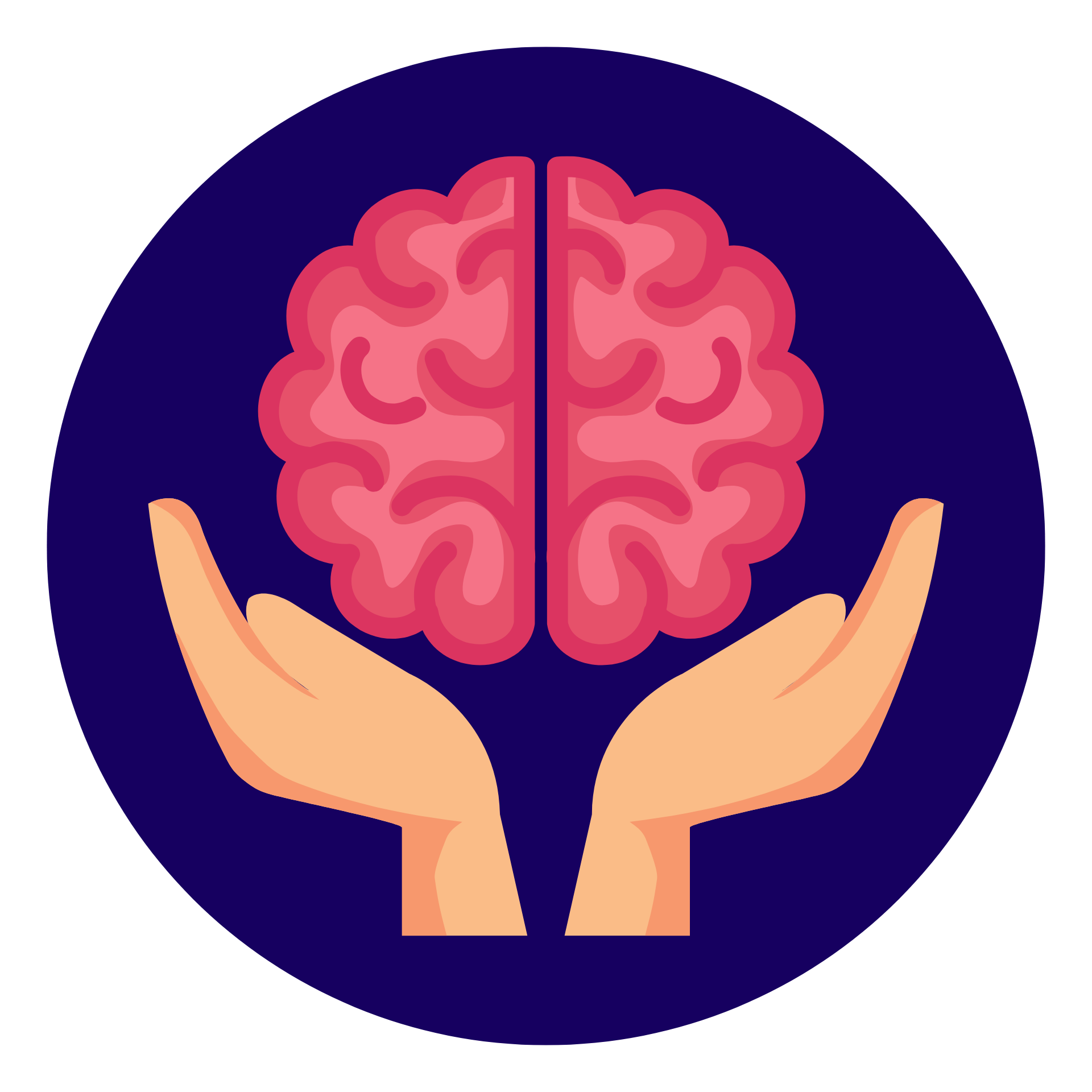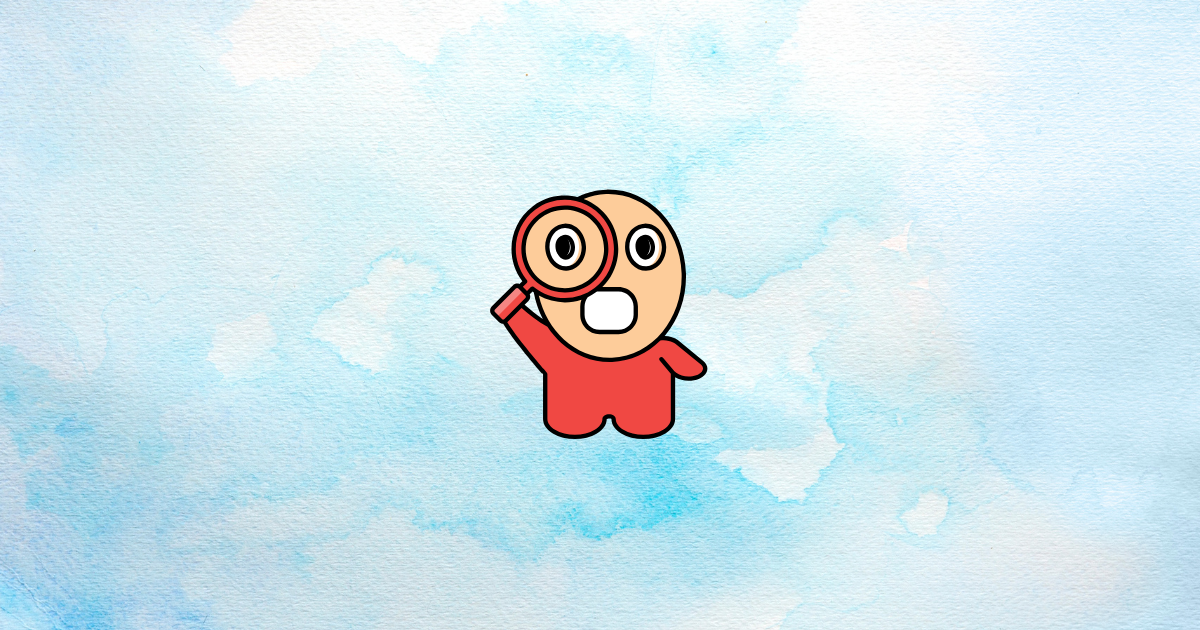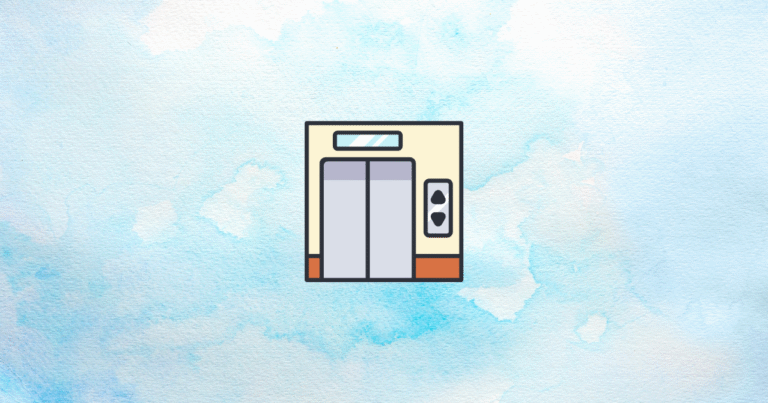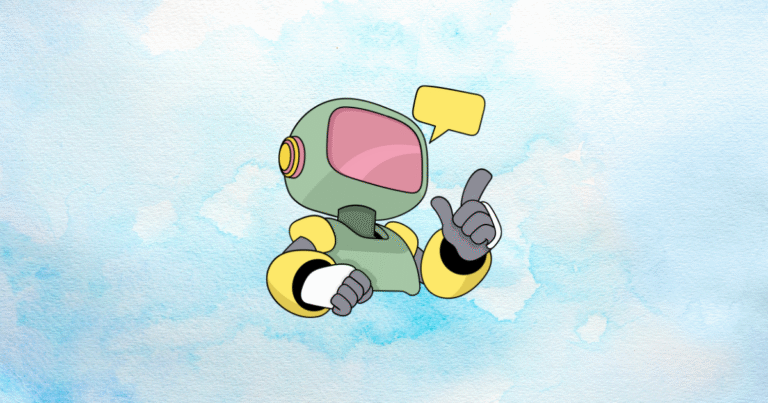In this article, you’ll discover how the science of curiosity can revolutionize your Shopify content strategy. You’ll learn practical techniques backed by neuroscience that can increase engagement, extend session times, and ultimately drive more conversions. By the time you finish reading, you’ll have a toolkit of curiosity-triggering strategies that your competitors probably haven’t even heard of yet.
Ready to turn your customers’ natural desire to know into a powerful marketing advantage? Let’s dive in!
The Neuroscience of Epistemic Curiosity
Before we jump into tactics, let’s understand what happens in your customers’ brains when curiosity strikes. This isn’t just marketing theory—it’s brain science that explains why certain content compels people to keep reading, clicking, and ultimately, buying.
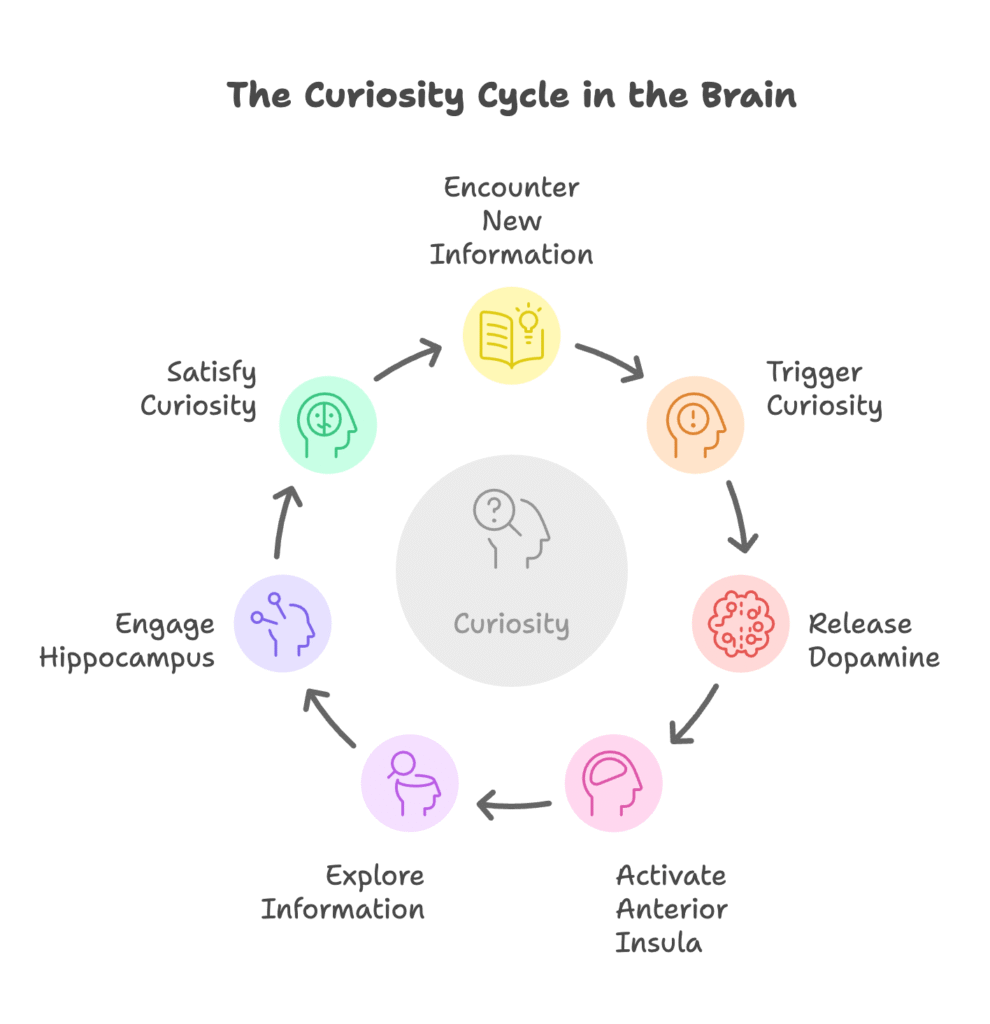
Dual Processing Pathways
Your brain experiences curiosity in two distinct ways:
- I-Type Curiosity (Interest-based): This is the pleasant, anticipatory feeling you get when encountering something new and interesting. When triggered, your brain releases dopamine—the same reward chemical activated by food and social media likes. This makes curiosity literally addictive in the most positive sense.
- D-Type Curiosity (Deprivation-based): This is the slightly uncomfortable feeling when you sense a gap in your knowledge. It activates your anterior insula, creating a mild tension that can only be relieved by finding the answer. Think of it as an intellectual itch that needs scratching.
Neural Triggers
Three key brain regions light up during the curiosity cycle:
- Your ventromedial prefrontal cortex activates when you recognize there’s something important you don’t know yet.
- Your hippocampus (memory center) engages as you explore new information, helping you connect it with what you already know.
- Your nucleus accumbens—the brain’s reward center—delivers a pleasure hit when curiosity is finally satisfied.
What does this mean for your Shopify content? By designing content that creates strategic information gaps, then satisfies them, you’re literally activating a reward cycle in your customers’ brains. But how exactly do you create those perfect knowledge gaps without frustrating your visitors? That’s exactly what we’ll explore next…
Psychological Triggers for Shopify Content
Now that we understand the brain science, let’s translate it into practical content techniques. This section reveals how to engineer the perfect level of curiosity that keeps customers engaged without overwhelming them.
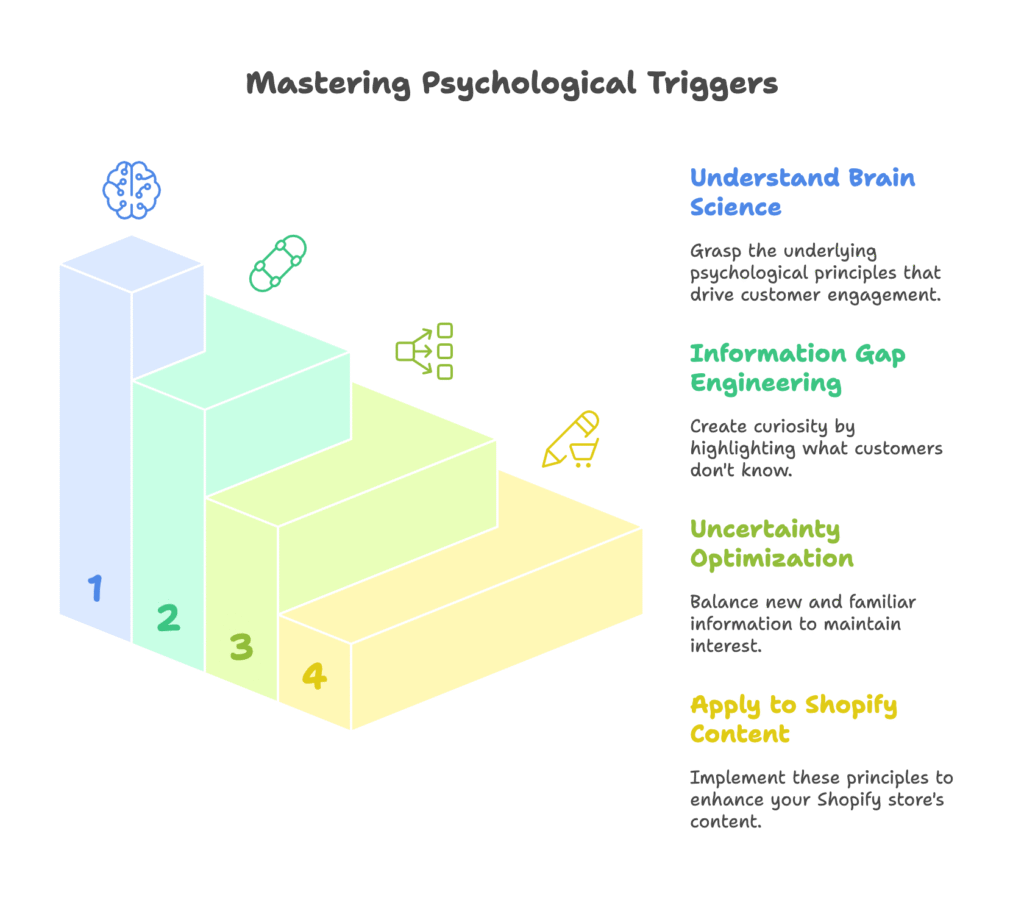
Information Gap Engineering
Information gaps are the space between what someone knows and what they want to know. Here’s how to create them effectively:
- Diagnostic Frameworks: Tools that help customers discover what they don’t know about themselves or their businesses. Examples include:
- “What’s Your E-commerce Readiness Score?” quizzes
- Interactive assessments like “How Optimized Is Your Product Page?”
- Progressive Disclosure: Revealing information in strategic layers:
- Multi-stage blog series (clearly labeled “Part 1 of 3”)
- Scrollytelling product journeys that reveal features as customers scroll
Uncertainty Optimization
Too little uncertainty is boring; too much is overwhelming. Here’s how to find the sweet spot:
- Optimal Complexity Thresholds:
- Research suggests content with 30-40% new information (with 60-70% familiar concepts) creates the perfect level of curiosity
- Limit each content section to 5±2 key points (following Miller’s Law of working memory capacity)
- Controlled Ambiguity:
- “How It Works” animations that reveal part of your product’s functionality but leave some aspects intriguingly unexplained
- Industry trend reports that offer clear data but leave room for customer interpretation
These psychological principles might seem subtle, but they create a powerful pull on your customers’ attention. But let’s get even more practical—how do you apply these principles specifically to your Shopify store’s content? Let’s explore the exact tactics next…
Shopify-Specific Content Strategies
Now we’re getting to the really good stuff—exactly how to implement curiosity triggers across different parts of your Shopify store. These practical tactics can be implemented right away to transform your content from ordinary to irresistible.
Product Page Tactics
Your product pages are where curiosity translates directly into sales. Here’s how to optimize them:
- 360° Views: Instead of showing everything at once, use prompts like “Swipe to discover the hidden compartment” to encourage exploration
- Ingredient Lists: Introduce intriguing scientific terminology with simplified explanations (e.g., “Contains 23% Bakuchiol—the plant-based compound dermatologists are calling ‘nature’s retinol'”)
- FAQ Sections: Use unexpected question formulations like “Why do experts avoid this common feature?” (making customers curious about what experts know that they don’t)
Blog & Educational Content
Your blog is curiosity’s playground. Optimize it with:
- Mystery Headlines: Create knowledge gaps that demand closure:
- “The E-commerce Tactic That Amazon Doesn’t Want You to Discover”
- “Why 92% of Shopify Store Owners Miss This Simple Conversion Opportunity”
- Interactive Tools: Engagement multipliers that leverage curiosity:
- Calculators that reveal personalized insights (“See how much revenue you’re leaving on the table”)
- “What If” scenario builders that let customers explore different outcomes
Email Campaign Architecture
Email sequences are perfect for extended curiosity loops:
- Socratic Sequencing: A three-part formula:
- Email 1: Pose an intriguing question (“Is your checkout process secretly driving customers away?”)
- Email 2: Provide partial answer + introduce deeper question
- Email 3: Deliver complete solution + call-to-action
- Curiosity Loops: Connected knowledge journeys:
- Each email resolves the previous curiosity gap while opening a new, related one
- Example: “Now that you know X, you’re probably wondering about Y…”
These tactics are powerful, but they also come with responsibility. How do you ensure your curiosity triggers enhance customer experience rather than manipulate it? That’s the ethical question we’ll tackle next…
Ethical Implementation Framework
With great psychological power comes great responsibility. This section ensures your curiosity tactics build trust rather than undermine it. After all, the goal is to create customer relationships that last, not just one-time purchases.
Dark Pattern Avoidance
Here’s how to keep your curiosity triggers ethical:
- Gap Closure Guarantees:
- Always provide the promised answers within 3 clicks maximum
- Avoid infinite curiosity loops that never deliver the promised information
- Transparency Standards:
- Clearly label content types so customers know whether they’re reading educational or promotional material
- Include source citations for claims, especially surprising statistics
Cognitive Protection
Make your content accessible to everyone:
- Include complexity alerts for technical content (“Technical section ahead”)
- Provide glossary tooltips for industry-specific terms
- Add anxiety-reducing certainty anchors (“3 Guaranteed Takeaways”)
Implementing these ethical guardrails doesn’t just protect your customers—it protects your brand reputation too. But how do you know if your curiosity tactics are actually working? That brings us to measurement…
Measurement & Optimization
What gets measured gets improved. Here’s how to track and optimize your curiosity-driven content for maximum impact.
Neurometric Tools
For larger brands with research budgets, consider these advanced tools:
- Eye-tracking studies to identify which information gaps attract the most visual attention
- EEG measurements to detect spikes in dorsolateral prefrontal cortex engagement (a sign of active curiosity)
- Facial coding during curiosity resolution moments to measure emotional satisfaction
Behavioral Metrics
For everyday tracking available to all Shopify merchants:
- Scroll-to-Reveal Rates: What percentage of visitors scroll to discover hidden content?
- Multi-Page Completion Index: How many visitors complete multi-part content series?
- Content-Driven Product Searches: Do visitors search for specific products mentioned in your curiosity-driven content?
A/B Testing Protocol
Systematically improve your curiosity tactics:
- Test different gap intensities (compare 20% vs 40% novelty in content)
- Experiment with resolution timing (immediate vs delayed gratification)
These measurement approaches transform curiosity from an art into a science. But theory is one thing—real results are another. Let’s look at how actual businesses have put these principles into practice…
Case Studies & Results
Nothing speaks louder than results. Here are three examples of businesses that have successfully implemented curiosity-driven content strategies and the impressive outcomes they achieved.
Skincare Brand: 141% Blog Engagement Lift
A premium skincare Shopify store implemented what they called their “Biochemical Mystery” series:
- Tactic: A three-part blog series that progressively revealed the science behind their star ingredient, with teaser images of lab reports and microscopic ingredient photography
- Result: 141% increase in average time on page and 38% increase in consultation requests
SaaS Company: 63% Demo Sign-Up Increase
A Shopify app developer created curiosity-driven webinar funnels:
- Strategy: “What Your Competitors Know” webinar series that revealed industry-specific conversion tactics, with registration pages highlighting knowledge gaps
- Impact: 63% increase in demo sign-ups and 22% shorter sales cycles
Eco-Product Launch: 89% Social Shares
A sustainable product brand leveraged curiosity for their new product line:
- Approach: Interactive “Hidden Environmental Cost” calculator that revealed surprising impacts of conventional products versus their eco-alternatives
- Data: 89% increase in social sharing and, for those who participated in a lab study, 41% higher activation in the ventral striatum (the brain’s reward center)
These case studies show the real-world power of well-designed curiosity triggers. But what’s next on the horizon for curiosity-driven commerce? Let’s peek into the future…
Future of Curiosity-Driven Commerce
The intersection of neuroscience, psychology, and e-commerce is evolving rapidly. Here’s where curiosity-driven content is headed next and how you can stay ahead of the curve.
Emerging Technologies
Watch for these innovations in the curiosity space:
- AI-Personalized Knowledge Gaps: Systems that analyze a customer’s previous interactions to create perfectly calibrated information gaps within their “Zone of Proximal Development”—not too easy, not too challenging
- Blockchain-Verified Mystery: Using NFTs to create exclusive, verifiably scarce content tiers that progressively reveal premium information
- Biometric Feedback Systems: Technology that detects physical signs of curiosity (like pupil dilation) and adapts content in real-time to maintain optimal engagement
Predictive Models
New ways to quantify curiosity’s business impact:
- Curiosity LTV Scoring (CLTV): Models that predict customer lifetime value based on their curiosity engagement patterns
- Gap Closure Velocity Index: Measuring how quickly customers move from curiosity trigger to curiosity satisfaction to purchase decision
While some of these technologies are still emerging, the fundamental principles of epistemic curiosity remain constant. By implementing the tactics we’ve explored today, you’ll not only boost engagement and conversions now but also build the foundational skills for the future of curiosity-driven commerce.
And speaking of boosting conversions, if you’re looking for a powerful way to apply these curiosity principles to your Shopify store, Growth Suite can help. This app intelligently tracks visitor behavior, identifies potential customers who might not convert, and presents them with personalized, time-limited offers that leverage the same principles of curiosity and urgency we’ve discussed. It’s like having a curiosity expert built right into your store!
References
- Litman, J.A. (2005). Curiosity and the pleasures of learning: Wanting and liking new information. Cognition & Emotion, 19(6), 793-814. https://www.tandfonline.com/doi/abs/10.1080/02699930541000101
- Gruber, M.J., Gelman, B.D., & Ranganath, C. (2014). States of curiosity modulate hippocampus-dependent learning via the dopaminergic circuit. Neuron, 84(2), 486-496. https://www.cell.com/neuron/fulltext/S0896-6273(14)00804-6
- Kang, M.J., Hsu, M., Krajbich, I.M., Loewenstein, G., McClure, S.M., Wang, J.T., & Camerer, C.F. (2009). The wick in the candle of learning: Epistemic curiosity activates reward circuitry and enhances memory. Psychological Science, 20(8), 963-973. https://journals.sagepub.com/doi/10.1111/j.1467-9280.2009.02402.x
- Jirout, J., & Klahr, D. (2012). Children’s scientific curiosity: In search of an operational definition of an elusive concept. Developmental Review, 32(2), 125-160. https://www.sciencedirect.com/science/article/abs/pii/S0273229712000184
- Growth Suite Shopify App. https://apps.shopify.com/growth-suite
